Transforming Utility Fleets with Telematics

Managing a utility fleet presents unique safety, logistical, and efficiency challenges. Utility fleets typically have a wide variety of specialized equipment and trucks for specific applications. Crews often maneuver and operate trucks and equipment in extreme weather conditions and hazardous situations. Crews, trucks, and equipment are often geographically dispersed.
Despite these challenges, millions of times a day managers of utility fleets successfully get the right crew, trucks, and equipment to where they are needed — quickly and safely. And what’s their secret weapon? Telematics.
Telematics: A Powerful Tool for Transforming Utility Fleets
Telematics combines telecommunications, informatics, and wireless devices to send, receive, and store data. It helps simplify and streamline the management of utility crews, trucks, equipment, and operations through tracking hardware, cloud-based software, and mobile applications.
With the ability to process and analyze data on critical assets collected by telematics devices, utility fleet managers can make quicker, data-driven decisions that optimize fleet management and operational efficiency and help fleets save money over the long term. The following are three key areas of utility fleet operations that telematics can transform.
Customer Service:
Speed and accuracy are crucial when restoring electricity, water, gas, or telecommunications. Customers expect it. And their safety and security depend on it. The holistic view of an entire fleet telematics provides ensures it.
Telematics provides real time information on assets — information that’s critical at any time, but particularly invaluable during a natural disaster or severe weather event.
By leveraging telematics, utility fleet managers can improve customer service by improving efficiencies. They can send instructions and alerts in real time to their crew. They can identify the location of the nearest truck and equipment needed for a job and then determine the quickest, safest way for their crew to get there. They can share a live location with customers and track their crew in real time to give customers fast, accurate information regarding crew arrival time and service restoration time.
Maintenance:
Telematics can help utility fleet managers take a predictive approach to maintenance. Unlike preventative maintenance, predictive maintenance uses historical data to improve fleet efficiency by identifying failure patterns over time.
With utility fleets using so many different kinds of equipment and trucks — each performing unique tasks and having unique needs — predictive maintenance is helpful in that it identifies which trucks or equipment need maintenance more regularly and what problems occur more frequently. It tells utility fleet managers what trucks and equipment are doing in the present and what they will do in the future.
With real time data and alerts, problems are flagged before major failures occur. This reduces unplanned downtime and spending on replacement parts and allows technicians to focus on diagnostic work rather than lengthy repairs — resulting in greater efficiency, productivity, and savings.
Safety:
The safety of the crew and the security of trucks and equipment is always a top concern in everyday situations and in situations where utility crews are deployed hundreds of miles from their home base. With real time alerts, tracking, and monitoring capabilities, telematics can help utility fleet managers enhance both fleet safety and public safety.
With real time alerts on risky driving behaviors such as speeding, hard braking, and rapid acceleration, telematics provides utility fleet managers insight into individual driver performance that’s used to coach and train drivers. Better drivers are safer drivers and safer drivers mean lower fuel and maintenance costs.
Telematics also helps utility fleets improve emergency response times and improve public and crew safety by providing greater asset visibility — a clear picture of what’s going on with the crew, trucks, and equipment. When an emergency occurs, utility fleet managers can see their entire fleet and location and make real time decisions on what assets to utilize and the quickest and safest route to take.
Choose a Provider Wisely
If telematics looks like a good fit for your utility fleet, do your homework — there are thousands of providers to choose from. Cost is a top consideration, but it’s not everything. Qualifications to look for in a telematics provider include:
- Well-established in the industry, with a solid reputation and a history of developing new technologies
- Works with you to make the most of your budget
- Offers quality devices that are backed by 24/7/365 support
- Partners with other companies to offer integration with third-party applications at no charge
- Ensures compliance
Understand of how telematics can optimize utility fleet fuel consumption, safety, and maintenance by downloading our eBook.